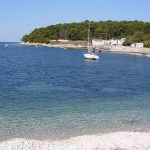On the south side harbor quay of Vela Luka, Korcula, one will find many small restaurants and cafes that flank the seaside promenade and look out toward the open waters and the small island of Proizd just a few hundred meters into the bay. On fine summer nights, when the tourist season is in high swing, it’s nearly impossible to find a spot at any of these restaurants or adjacent cafes, so people queue up early. One of the most popular choices is an age-old Vela Luka institution called Restaurant Ribar, which is owned by my cousin Marina and her partner Ante. The restaurant is one of the oldest in town with a tradition going back as far as the 1960s and pre-dating the time when it was acquired by my cousin and her partner.
One of the reasons why the restaurant gets so much foot traffic is because of the adjacent house – meaning, the stone home to which its left side wall is connected to, belongs to the Croatian singing sensation Oliver Dragojevic. Year over year guests who are life-long regulars come specifically because of this connection in the hopes of catching a glimpse of the great man himself (he does occasionally walk by and sit down with the bar staff, but only when he feels like it and never under pressure). The other reason it is so popular is that, as its name suggests, Restaurant Ribar is the best bet in town for fresh local fish and offers a unique seafood experience. Now, I don’t just say this because it is owned by family members, rather the testimonials of hundreds who came back summer after summer and who swear by the menu, preferring it to other establishments in town. These include both local Croatian celebrities and politicians as well as foreigners (stay tuned because in the next few days I’m going to write another piece about the restaurant’s connection to the British Royal Navy and the numerous naval frigate staff who have dined there (some, including royalty).
Despite all this welcome attention, there is one aspect of the familiar stone building which houses Restaurant Ribar that few are aware of. I certainly wasn’t until 2015 when I was told the most incredible story ever, a story I feel compelled to share as it evokes a provocative time in Croatian history and paints a poignant picture of the resilience of Korcula’s inhabitants and their quick thinking.
During the summer of 2015, I spent two weeks in Vela Luka visiting my cousin and taking advantage of one of the spare guest bedrooms on the upper floor of the restaurant, the kind usually reserved for seasonal guest workers. Somewhere in the middle of my stay, the restaurant got extremely busy at just about every hour of the day. Rather than watch my cousin and her seasonal staff struggle with the volumes, I decided to help by serving meals and taking orders. At some point, as I was doing this my cousin asked me to go upstairs into the attic and bring down some provisions for the kitchen. Until that point, I was not even aware that the restaurant had an attic. I asked her how to get there and she pointed to a set of stairs behind the second level closet area. It was a little terrifying as the staircase leading to the attic was really just a wooden plank that had to be navigated carefully.
When I reached the attic, I noticed that it was the size of a tiny Dalmatian konoba pantry. There were lots of old things lying about in addition to jars of pickled beets, onions, potatoes, and other staples restaurants rely on. The attic also had two very tiny stone windows which were shut tight by wooden shutters. I wondered why I had never noticed this space before and from street level could barely recall even seeing the windows, yet there they were in plain sight. Without giving it too much thought, I gathered the provisions I needed and began the descent back down. Before closing the door, I noticed paperwork scattered across the wooden floor that looked yellowy-brown and newsreels from what looked like the old Yugoslav gazette of Vijesnik, clearly dating as far back as the 1950s or 1960s. Relics of old things lay about mixing with the potato bins and prsut hanging from swing racks on the wall giving the space a very eerie feel.
I made my way downstairs, handed my cousin the provisions, and busied myself with serving guests. When the last guests had left for the evening, we closed up the restaurant and headed to the courtyard veranda where my cousin, myself, and some of her seasonal guest workers (that summer’s brood hailing from Slavonia), sat under the grape canopy and sipped on schnapps and loza. While we were sitting there and resting our tired feet I turned to my cousin Marina and told her I couldn’t believe there was an attic in the building considering it was my third summer staying there and I had never noticed it before.
My cousin took a long puff of her cigarette and asked me if her partner, Ante, had ever told me the story of the attic. He hadn’t. Marina raised her eyebrows as if thinking how to tell me what she wanted to say and took her time. By this point, I was so intrigued I couldn’t guess what the story could involve but I was certain it either had to do with the sad local ghost of some unfortunate suicidal girl or rumors of a body found upstairs. I’d take either or as both made for a compelling dinner story to share with future travelers. “No, it’s nothing like that,” said Marina. Instead, she proceeded to tell me one of the most incredible stories I had ever heard, and you are about to find out why.
It turns out that during the period of the Second World War, the building which now houses Restaurant Ribar belonged to an Italian family (as did many such buildings on the Dalmatian and Istrian shore). The family had been approached by friends in Zagreb asking if they could assist their neighbors, a Jewish family that was seeking to escape and find shelter in the Italian-occupied zone, which the Dalmatian islands were then a part of. The Italian family responded positively and for over a year hid and harbored the Jewish family in the attic room, the same room which now held provisions for the restaurant. Marina went on to tell me that she had heard this story from her former Mother-in-Law as well as numerous townspeople who recalled that dark era. I couldn’t believe that a family of four could have survived in that attic for as long as they had but people will do incredible things to stay alive.
In the 1960s and 1970s the little girl who was the daughter of the Jewish couple and was now a grown woman living in Israel, came to Korcula to see the building that had acted as a safe house for her and her family during those terrible months of WWII. I don’t know her name and neither did Marina, but the Jewish lady mentioned that during those dark times, one of her only pleasures would be when her father would lift her up to look out the attic window into the scenes of life taking place on the quay below. Hearing this made me incredibly sad and reminded me of the Anne Frank story to some degree.
It’s incredible to think that history had shaped the building and left its mark on it, yet anyone walking by even today will hardly notice those two twin shaped attic windows or have any idea of the role the building played in saving an innocents life. Stumbling across this story was so incredible for me and it constitutes such a fantastic piece of local history that I wanted to preserve it in writing. So, the next time you happen to be in Vela Luka and are walking along the southern quay, stop in front of Restaurant Ribar and be sure to look up towards its roof. There you will see two small windows which, although insignificant to the eye of the casual observer, played a larger than life role in saving someone’s life during the darkest hour.









